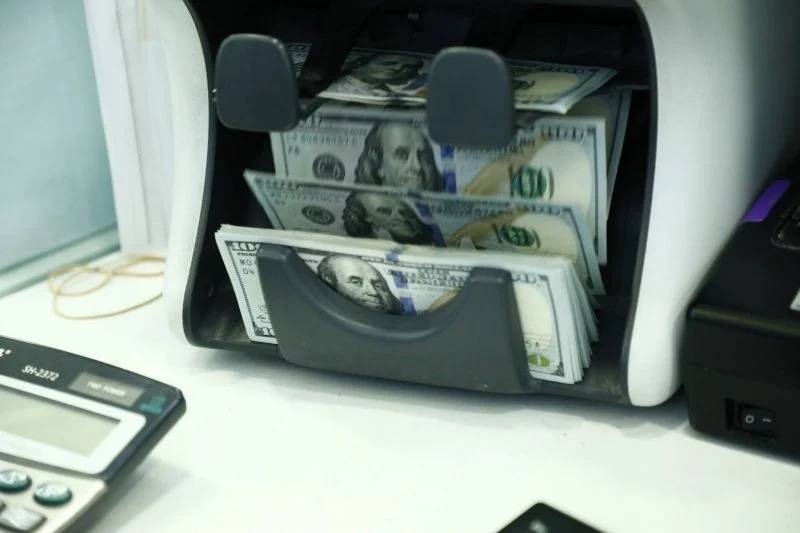
By opening its floodgates on March 21, the BDL managed to readjust the Lebanese lira's parallel market exchange rate by more than 32 percent. (Credit: Marc Fayad)
Made available to commercial banks since Dec. 16, 2021, through BDL Circular No. 161, this mechanism involves the central bank, commercial banks and their customers, and serves as a tool for BDL to stabilize the exchange rate and reduce speculation against the lira, which has lost more than 98 percent of its value against the US dollar on the parallel market since the onset of Lebanon’s economic crisis in 2019. In a nutshell, this mechanism consists of injecting foreign currency at the Sayrafa rate, which is lower than the parallel market rate, in exchange for Lebanese lira in cash.
Since January 2022, BDL executed no fewer than six official interventions to this end, the most recent of which took place on March 21. Although the interventions’ effectiveness was criticized on several occasions, they remain BDL’s favorite reaction to lira market volatility. Indeed, the sixth intervention, of March 21, may be giving critics pause to think again, as it is proving to be much more effective than past attempts, managing to strengthen the Lebanese lira by more than 32 percent and to stabilize its rate at around LL97,000 to the dollar for the past 20 days.
“Mission accomplished,” some would say. But others might add, “Sure, but for how long?”
Appreciation of 32 percent
Two points of view appear to prevail. The first believes that BDL will continue to intervene at least until the end of April, giving civil servants time to convert their salaries from lira into dollars at a favorable rate. The second believes that the calm before the storm could last until the end of the BDL governor’s term of office, scheduled for the end of July, after which the parallel market exchange rate will most likely sharply rise again.
The results of BDL’s previous interventions have shown this: they created cycles of sharp depreciation, followed by a sudden appreciation and then a new depreciation that is more or less rapid.
Prior to this latest intervention, the time required for the exchange rate to reach its pre-intervention level following the intervention’s execution became shorter each time. It took 134 days following the first intervention, 111 days after the second, 36 for the third, 16 for the fourth and only 10 for the fifth. However, 37 days have already passed following the sixth intervention, and the parallel market exchange rate is still far from hitting its peak of LL143,000, reached on March 21, the date of the last BDL intervention, making it the third most sustainable intervention so far.
The provisional assessment of this sixth intervention is even better in terms of effectiveness. While the appreciation rate has steadily decreased since the mechanism has been in force, the most recent intervention resulted in the best ratio. At over 32 percent, it is still higher than the 28.8 percent recorded following the first first intervention, the 26.3 percent recorded for the second, the 13.8 percent recorded for the third, the 12.1 percent recorded for the fourth, and the almost 12 percent recorded for the fifth.
A counterproductive role
But do these results justify BDL’s interventions? It is difficult to answer, given the lack of transparency regarding the means through which this mechanism is implemented.
Economic expert Patrick Mardini said, “It is even BDL’s intervention on the exchange market that is the source of so much volatility.”
This is because BDL injects dollars through the Sayrafa platform from two sources: its foreign exchange reserves made up of the commercial banks’ deposits at the central bank and the currencies purchased on the parallel market with the Lebanese lira it prints.
Given the lack of information, it is impossible to verify which procedures were used and to what degree during each intervention. It is even more difficult to measure how many dollars BDL purchased on the parallel market before reselling them and bringing the rate down again.
“What is certain, however, is that by printing and selling Lebanese lira in this way, BDL’s role becomes counterproductive, since it contributes to the depreciation of the local currency before strengthening it, accentuating its fluctuations even more,” Mardini said.
These effects will be all the more visible, he said, when government-mandated minimum wage and salary increases come into effect on May 1, although their financing is still not secured.
For his part, Nassib Ghobril, head of the economic research and analysis department at Byblos Bank, believes that the exchange rate volatility is not only related to BDL’s interventions on the market. He says the volatility is also caused by “speculators who take advantage of these fluctuations and who have no interest in the parity dropping,” adding that “one must also take into account the demand for the dollar by foreign countries who come to buy it in Lebanon.”
In the absence of reforms and strong signals that would put economic activity back on track, it seems that the country is for the time being deemed to move from one cycle to another, with increasingly sharp fluctuations, away from any stabilization.
The level of currency in circulation in Lebanon and the exchange rate have more than doubled in a year.
“As long as we keep printing lira, depreciation is inevitable,” said Mardini.
This article was originally published in French in L'Orient-Le Jour. Translation by Joelle El Khoury.